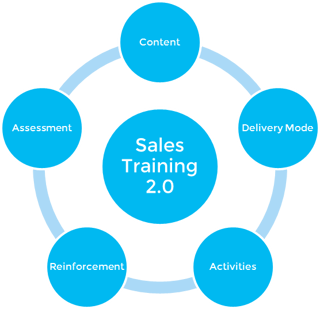"U.S. firms spent about $156 billion on employee learning in 2011, the most recent data available, according to the American Society for Training and Development. But with little practical follow-up or meaningful assessments, some 90% of new skills are lost within a year.” – Wall Street Journal.
Every year, close to 95% of all U.S. companies invest in some kind of sales training and nearly half spend up to $5K per rep. Yet, study after study tells us that today’s sales training just doesn’t work. At best, sales training amounts to little more than a performance bump for the current quarter, and then everyone drops right back to where they started, struggling to make the numbers.
Why do most sales training programs fail?
Through our efforts to help hundreds of companies with their sales training programs, we've identified 5 common mistakes that lead to sales training failure. They include confusing product training with sales training, treating sales training as a one-time event, and failing to involve sales managers in training initiatives. To see our in-depth study on sales training mistakes and learn strategies that can help you avoid them, download this free resource.
The most common sales training mistake
The most common mistake that companies make in their sales training programs is being lured into thinking a particular selling strategy or methodology is the solution. This perspective inevitably leads to an over-emphasis on the “what” and giving little or no consideration to the “how”.
In this model, sales leaders seek to introduce a particular selling framework or strategy to their salesforce. These executives might first evaluate different selling frameworks to find the one that best aligns with their sales objectives. But whether it’s Challenging, SPINning, Strategic, Conceptual or Solution Selling, these programs are essentially expensive, often stale, off-the-shelf content: words, big ideas, and maybe a few colored worksheets.

Beyond the content, the more important issue is that little or no real consideration is given to how, exactly, are the reps supposed to learn and adopt the new strategies? What approach will you use to deliver the content so that the sales organization will actually absorb it? How can the concepts be practiced, assessed, and reinforced? Selecting sales training content without thinking through the learning process would be like a college professor selecting the book for the semester with no thought given to the any other aspect of the course.
How can you avoid it?
Effective sales training drives true learning and behavior change. To achieve positive ROI, your sales training program needs to be a complete system: content combined with a set of additional components.

World-class sales organizations treat sales training as a structured process that includes quality content, methods of delivering the content, activities to drive home the content, plans to reinforce the content, tools and job-aids that support application, and assessments to evaluate learning success and potential gaps.
Whether you’ve felt the pain and want to avoid it next time, or you’re ahead of the game and want to position you and your firm for success, you need know why sales training fails. More importantly, you need to know how to address these common pitfalls to create an effective and lasting training program for your sales team. To find out more about common sales training mistakes and learn strategies that can help you avoid these issues, download our free sales training ideas eBook: Avoiding the Pitfalls of Sales Training.
About The Author
 Researcher, consultant, and sales leader, Brian uses a data-driven approach to drive sales effectiveness. His clients include leading sales organizations in financial services, technology, healthcare, and professional services. Using insight from academics and change management, Brian helps senior leaders and sales enablement teams understand and succeed in today’s more demanding market. His research has been published in Harvard Business Review and other outlets.
Researcher, consultant, and sales leader, Brian uses a data-driven approach to drive sales effectiveness. His clients include leading sales organizations in financial services, technology, healthcare, and professional services. Using insight from academics and change management, Brian helps senior leaders and sales enablement teams understand and succeed in today’s more demanding market. His research has been published in Harvard Business Review and other outlets.




